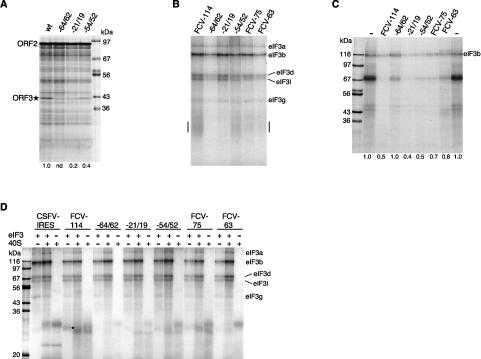Figure 6.
Correlations between reinitiation efficiency and the eIF3 or 40S binding of various mutant derivatives of the 3′-terminal ORF2 element. (A) Translation assays of uncapped transcripts of pCSFV-2/3* wild-type control, and (in the same background) GGG−64/62 → CCC, AGU−21/19 → UUA, and UUG−54/52 → AAU mutants. Numbers below each lane show the relative reinitiation efficiency determined and defined as in Figure 4. (B) UV-cross-linking assays of purified eIF3 (200 nM) with the following labeled probes: the 3′-terminal 114 nt of ORF2 wild type and the three point mutants described above, and the 75-nt and 63-nt truncations. The bar in the margins highlights the smeared signal at ∼29 kDa discussed in the text. (C) UV-cross-linking competition assays with HeLa cell extract, the wild-type 114-nt 3′-terminal ORF2 element as labeled probe, and a 200-fold molar excess of the same set of point mutants and truncation mutants as unlabeled competitors. Numbers below each lane show the intensity of the eIF3b signal relative to the average of the two outside lanes with no competitor (−) set at 1.0. (D) UV-cross-linking assays with 160 nM eIF3, or 80 nM purified 40S subunits (or both together), as indicated, and the same labeled probes as in B. In order to reveal the weak 40S subunit cross-linking signals, the autoradiogram was deliberately overexposed, which resulted in some loss of differential eIF3 signal intensity between the various mutants, due to film saturation. The cross-linking signal attributed to eIF3k in the assay of FCV-114 and eIF3 alone is highlighted with an asterisk to the right of the relevant lane.

